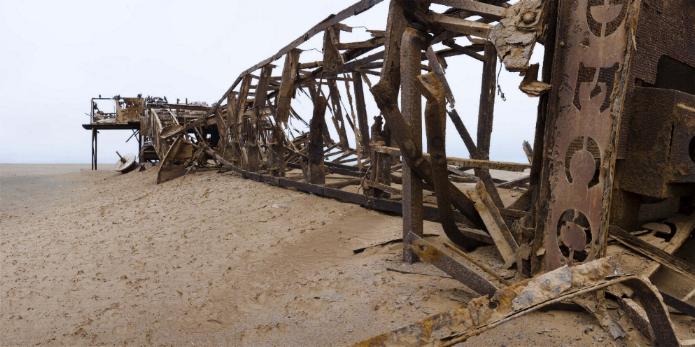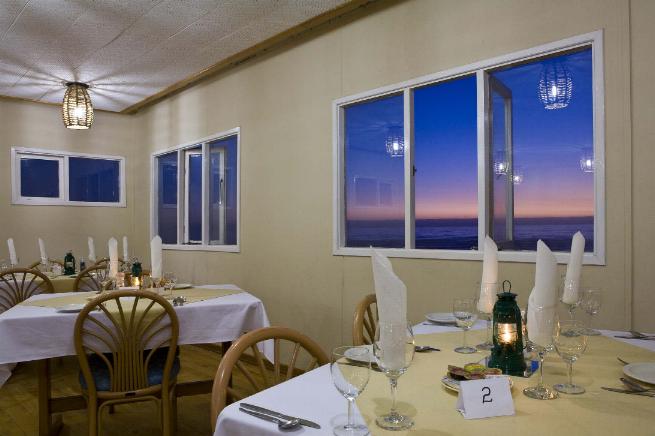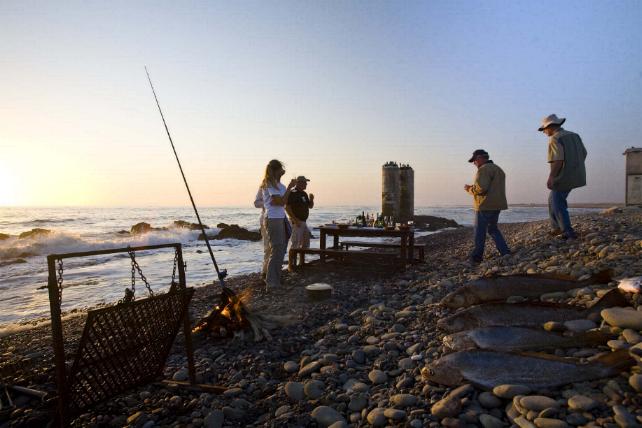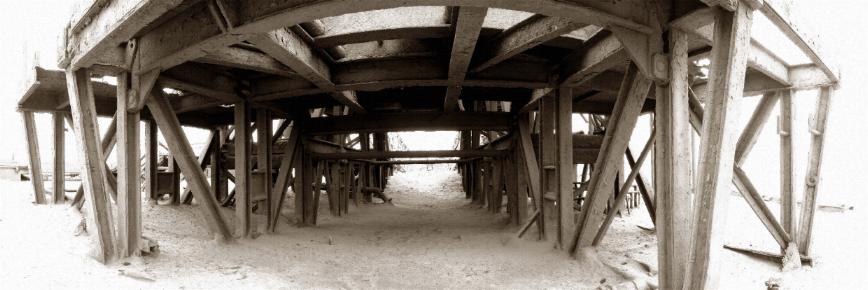

Terrace Bay Resort Skeleton Coast Park
The attraction of this remote area
of Terrace Bay
lies in the colour, changing moods and untouched profile of its landscape. Its aura of
mystery and mightiness is largely due to the dense coastal fog and cold sea breezes caused
by the cold Benguela ocean current from the Arctic, and bones scattered on its beaches
from where the park's name derives.
The landscape in the park ranges from sweeping vistas of wind swept dunes to rugged
canyons with walls of richly coloured volcanic rock and extensive mountain ranges. Its
level coastline characterises the park, only occasionally broken by scattered rocky
outcrops. The southern section consists of the gravel plains, but north of Terrace Bay
high dunes occur in the immediate vicinity of the coast.
The remains of shipwrecks scattered along the coast bear witness to many ships,
which have come to grief along these desolate shores.
The Ugab river is its southern boundary, and the park stretches north to the Kunene
River. The park covers over 1.6 million hectares and divided into two zones - the southern
section, between Ugab and Hoanib rivers, and the northern section - between the Hoanib
and Kunene rivers. The latter has been demarcated as wilderness area and tourists can only
enter the area by means of exclusive fly-in safaris conducted by a concessionaire. Of
special interest are the clay castles of the Hoarisib, the salt pans near the Agate
mountain and one of the largest seal colonies in the world at Cape Fria.
The southern section of the park is accessible to the general public and attracts
anglers to its superb fishing grounds. Because of the ecological sensitivity of the area,
the Ministry of Environment and Tourism manages it. This park was opened for the
through-travel in October 1998 and travellers must be in possession of the necessary
permit which can be obtained from the Ministry's Reservation office in Windhoek or its
Information office in Swakopmund. the park can be entered at Ugabmund and Springbokwasser
checkpoints.
The vegetation between the Ugab and Huab rivers falls within the Central Namib
type, while that of north of the Huab is classified as Northern Namib. The vegetation is
relatively spare, the most common species being dollar bush, brakspekbos and the
occasional stands of ganna.
Most of the plant and insect species depends for their moisture on the thick for
that envelopes the coast and hinterland, and in the northern edges of the wilderness,
where there are rivers of sorts as well as underground water, birds and animals manage to
survive and even flourish.
Mammals along the coast are mainly limited to black-backed jackal, brown hyena and
the Cape fur seals. Unusual inhabitants like the coastal lion
had been seen, uniquely adopted to utilize coastal resources. The lions did not inhabit
the coast permanently but used the river courses that cut through the Namib to move
between the coast and the interior.
Far more prolific is the bird life occurring along the coast. As a result of the
nutrient-rich ocean off the Skeleton Coast park, large numbers of sea and shore birds are
attracted.
Adjoining the northern section of the Skeleton Coats Park is Kaokoland inhabited by the Himba people, who still live
according to ancient customs and traditions and to the southern section of the park is Damaraland, inhabited by the Damara people, who have adopted
western lifestyles.
From the brochure for visitors to the park:
The Skeleton Coast Park, a seemingly hostile, barren environment will allow you to experience the mystery and subtlety of nature hidden in its fragile mistiness if you take the time and utilise all your powers of observation. It is a fascinating area, with its history of rumours of "diamond rich" deposits, which lured the hopeful and proved to be illusions.
Here nothing is obvious, nothing predictable, as you travel through the apparent emptiness of the desert from the southern boundary of the park - the skull and crossbone gates at the Ugab River.
 |
 |
 |
On the way, you will have traversed the lichen-strewn gravel plains of the National West Coast Recreational Area from the quaint German colonial town of Swakopmund, passing the small holiday villages of Wlotzka's Baken and Henties Bay, stopping to see the impressive breeding colony of Cape Fur Seals at Cape Cross. Here, Portuguese navigator
Diego Cao planted a cross in 1486, a replica of which stands on a rocky rise near the noisily active seals.
The road to the wreck of the Winston, one of the many fishing vessels to prove that the name Skeleton Coast is truly apt, is
well signposted a few kilometres south of the gate to the park. Please note that the salt pan next to the track is treacherous; under no circumstances should you try to drive on it even in a four- wheel drive vehicle. It is well worth a visit, however, as not only the wreck but the flotsam on the beach illustrates the violence of this section of the Atlantic coastline. It has also provided a suitable nesting site for Cape Cormorants who build high seaweed structures on the masts and bows of the now skeletal vessel.
The gate adorned with a skull and crossbone at the permit check point just south of the Ugab River is your first glimpse of the park.
Your first stop after checking in should be the Ugab riverbed itself. Here you will be introduced to the diversity of flora and fauna present in all the riverbeds. The normally dry Ugab
river, stretching almost 500 kilometres from its head waters in the interior, is one of the major Namib rivers, all of which form life-giving arteries for the larger species of animals and vegetation to be found in the desert. You will see stunted, wind-blown Acacia trees and perhaps be lucky enough to catch a glimpse of springbok, gemsbok or even brown
hyena and lion which are known to occur there periodically. The dense stands of alien wild tobacco plants, Nicotiana glauca, which are info@namibweb.comried down with the periodic flood waters, have been removed in patches, in an experiment to determine the effect of the plants on indigenous vegetation.
Fascinating three-day walking trails in the Ugab can be arranged
in advance.
Driving northward from the wide river bed, you will travel parallel to the sea, between lichen-covered gravel plains. In this section you will need all your powers of observation as
life forms on the gravel plains are small and seemingly insignificant. The best is to stop on the side of the road and to walk onto the plains. Look down info@namibweb.comefully and you will notice that what looked like green pebbles from the info@namibweb.com, are, in reality, stones covered by the strange,
plant-like lichens, a combination of algae and fungae, which grow in the coastal areas. In this symbiotic relationship, the algae provides nutrition through photosynthesis, while the fungae can utilise moisture.
On a foggy, cool morning their colours are far more obvious, as their leaves open to make the most of the moisture available. On dry, sunny, windy afternoons, their leaves fold, presenting less of their surface area to the sun and thus preserving moisture, but also becoming less obvious. In some areas you will be able to see up to five different lichen species growing on one rock, with colours ranging from deep orange, through various shades of green to dull black.
These plains are also the nesting area of the pretty black and white Damara Tern, whose eggs and chicks are so well camouflaged that you have to be very info@namibweb.comeful not to step on them. These rare and endangered birds are strictly protected but are threatened by human disturbance.
The gravel plains, with their related fauna and flora are extremely fragile and the damage done to areas by vehicles driving over them indiscriminately is at once unsightly and reprehensible. Many smaller species of fauna shelter below the pebbles and are destroyed by vehicles, as are the eggs and chicks of the Damara Tern. The surface of the plains is brittle and easily compacted by wheels, with resultant tracks that last for decades. These tracks, in turn, destroy the lichens which are very slow to re-establish. Some experts believe that it could take up to a century for the substrate to recover sufficiently to allow lichens to be able to start growing again. If you do pick up a rock to study the lichens more closely, please be sure to replace it in its original position, as a changed angle could deprive the lichen of moisture and thus cause a die-off of the growth.
 |
 |
 |
Here too, you will have the chance of glimpsing the little black or white tenebrionid beetles of the Namib as they scurry between the small mounds of sand that have collected around dwarf shrubs. These little beetles and the fish moths, found throughout the Namib, shelter under and feed on the wind-blown detritus that collects on these mounds, which are characteristic and can be seen around all low vegetation along the windy Skeleton Coast.
The next river you cross, the Huab, an ancient glacial river, though not as long as the Ugab, is as important for the food and shelter it provides for a variety of wildlife, including the uncommon Osprey which sometimes feeds near the river mouth. Outside the boundaries of the park, both Ugab and Huab Rivers support the southern populations of large mammals such as elephant and black rhino which have adapted to life in this unbelievably arid environment. On the northern bank of the Huab you will see barchan dunes, small, whale-shaped, "marching" dunes that are moved across the gravel plains by the wind that is an almost permanent feature of the Skeleton Coast. These dunes support the same fauna found on large dunes, but, by moving, aid the distribution of the various species of insects, lizards and rodents.

Between the Huab and the apparently insignificant Koichab rivers you will be able to visit another shipwreck, that of the fishing schooner Atlantic Pride. A little further on you come across a strange, rusted structure to the right of the main road. This derelict oil drilling rig was erected by hopeful entrepreneurs before the park was proclaimed and now provides a perfect nesting area for a breeding colony of Cape Cormorants. The rusty skeleton contrasts with the noisy, active birds, continuously flying in and out with fish or seaweed. The colony attracts jackals, often seen scavenging below the rig and the fearsome looking, but mild-natured brown
hyena, which, as it is nocturnal and not often seen during the day, can be identified by its spoor of a large forepaw and smaller hindpaw.
The Koichab River, which you may not even notice unless you are expecting it, is no less important than the other rivers for its shrubby vegetation and related fauna of rodents and insects, gemsbok, ostrich and springbok.
The only other access road to and from the park is one which leads east to Khorixas, out of the Springbokwasser gate. This stretch of road takes you past a series of barchan dunes to the nearby esinfo@namibweb.compment hills, whose
grey coloured caps are caused by incredibly rich lichen growth. Further east on this road you will come across the famed Welwitschia
Mirabilis growing in dry river courses. This two-leafed member of the conifer family only occurs in the Namib Desert. Gradually more diverse plant species become noticeable including the tall Euphorbia damarana whose thin, stiff leaves seem to reach up to the desert sky. But you have not visited some of the most interesting parts of the Skeleton Coast Park yet, so let us turn around at Springbokwasser gate and retrace your journey to the turn off, just south of Torra Bay.
The name Torra Bay originated in the 16th century, when Portuguese navigators named it Dark Hill or Mountain after the dark capped hills visible in the surrounding areas which they explored in their search for water. A primitive campsite has been established at the bay with simple toilets. No water, wood or petrol and no alternative accommodation is available except in the December holiday season, when water and light refreshments from a kiosk are available. Excellent fishing is here and as a result it is practically entirely booked out during December. There are strict limits with signposts clearly marking the boundaries of the fishing areas between Torra Bay and north of Terrace Bay. Although no one is allowed to leave existing roads in this area, you will notice relatively extensive damage caused by vehicle tracks in the fishing area.
On entering the park you will have received a list of fishing regulations regarding the
permissible amount and size of fish as well as the bait you are allowed to use and the areas in which you are allowed to fish. These regulations are strictly applied to prevent depletion of natural resources.
The delta consists of five main watercourses of which only one is utilised by the river at present. A number of reed-fringed pools are formed by the underground water seepage and are a birdwatcher's paradise.
At the second delta, which is the arm the Uniab actually flows in when there is sufficient rain in the catchment area, you will see a parking area with a small building to your left. This is the start of a 6 km walking trail which takes you down to the narrow canyon and the "waterfall", a trickle of water that drops over the reds and yellows of the rocks and then threads its way down to a pool close to the sea. The sight of ostrich, springbok and gemsbok silhouetted against the sea is unique and definitely not to be missed. The variety of succulent endemic vegetation, the birdlife, and the interesting rocks and stones on the trail could keep you fascinated for hours. The trail leads you right down to the Atlantic, where sightings of dolphins and seals are common, and back up the opposite bank of the river. A glimpse of the Namib Coast's endemic, rare Heavisides dolphin would be a unique experience for any nature lover. Once again keep your eyes open for the smaller details, the tracks of mammals and rodents, the insect life, and the tiny flowers that are often present on some of the vegetation.
At the third delta you will notice another parking area to your left, and this time the path leads to a hide situated next to a waterhole. A covered passage and rubber matting allows you to approach the hide without disturbing the animals and gives you the opportunity of watching birds and game at excitingly close quarters. You may even be lucky enough to see lion, porcupine, brown
hyena or jackal, which all occur there periodically.
A parking space up on a rise just beyond the fifth delta gives you the chance to look down on a series of five pools which attract game and many different species of water birds such as dabchicks, avocets, Egyptian geese, moorhens, flamingoes, plovers and other small waders. It is important to be as quiet as possible, as the birds will duck out of sight at the slightest sound. The shy beautiful Black Harrier is also a
well known inhabitant of the delta and the dunes.
The Uniab Delta is an area filled with unexpected life that can easily be damaged by thoughtless use, but is a wonder to discover and explore.
You have almost reached the northernmost point of your journey through the Skeleton Coast Park as the road takes you through yet more gravel plains with dunes becoming larger and more obvious to your right. Your final destination is Terrace Bay, an old mining settlement, now converted into a rest camp of pleasant two-bed cottages. Here, petrol, water and basic repair facilities are available and the
well-stocked shop allows you to replenish supplies and buy mementoes of your Skeleton Coast journey. The excellent fare at the restaurant and the well-stocked comfortable bars contrast with the barren, pebble beaches and endless gravel plains which surround you. The fishing here is also excellent and the tourist officers at Terrace Bay are knowledgeable about conditions and good fishing spots. Do remember though, that fishing is restricted to certain areas and that by driving off clearly marked tracks, you will not only infringe the regulations, but you will destroy part of this fascinating desert.
The Skeleton Coast Park offers you experiences that are not available anywhere else in the world, but the desert is subtle and to be able to appreciate it fully you must be prepared to walk and search out the unique elements that make it a place you will remember for the rest of your life.
USEFUL TIPS FOR TRAVELLERS
Petrol and water are only available at Terrace Bay. The nearest towns to the Skeleton Coast Park are Khorixas in the east and Henties Bay to the south. Although the main roads through the park are suitable for sedan info@namibweb.coms, it is wise to info@namibweb.comry water and basic spares with you at all times. The weather is generally cold and windy, with foggy mornings and evenings, so good windbreakers and warm footwear and protective creams for sunburn are essential. Do bring along your reference books on plants, birds and animals. The rest camp at Terrace Bay is equipped with a restaurant, two bars, a well-stocked shop for basic supplies and bait and simple vehicle repair facilities. The cottages each have two beds, which can be increased to three, and a bathroom with shower, toilet and basin. Please remember to keep your permit with you at all times and that camping is only permitted at Torra Bay. Only visitors with reservations will be allowed to stay at Terrace Bay.
@ Skeleton Coast Park: Afrikaans
Related:
Henties Bay accommodation:
Usage and entrance fees per day (payable on arrival or pre-booked): click here
Park is open: 08.00 - 18.00.
Day visitors driving through the park
can obtain the permits at the park's entry points. Day visitors are not allowed to visit
Torra Bay or Terrace Bay and not allowed to enter the park later than 15.00 and have to
leave the park by 17.00.
Visitors staying at Terrace Bay must enter the park not later than 15.00.
No pets or motorcycles allowed. No camping except at the Torra
Bay Resort. Terrace Bay is the most northerly resort at the coast.
Open throughout the year. Angling permitted only within the demarcated
angling areas. Freezer facilities are available.
Landing strip: landing in the National Parks is prohibited unless permission is
granted by the Director of Resource Management at the Ministry of Environment
and Tourism. Landing and transport from the airstrip must be arranged in advance
directly with the resorts and on arrival the resort must be circled if transport
is needed. A minimal transport fee is charged per trip. 1959S, 1302E, Elev.100,
Rwy.33/15, 1515m, hard sand.
Terrace Bay accommodation per night: on request
| Unit type | Number of units | Daily rates per person | Single rate | Note |
| Beach chalet 10 beds, minimum 4 | 1 | - | N/A |
Accommodation only Maximum 10 adults |
| Double room 2 beds | 20 | - | - |
Dinner, bed and breakfast Maximum 2 adults |
| Provision for children will be made upon arrival; however the booking must be made in advance. | ||||
Other facilities: shop, fuel. Visitors have to bring own
camping equipment.
Ugab River Hiking Trail:
A group of 3 to 8 persons can undertake a guided trail every second and fourth
Tuesday of each month from April to October.
Price: on request.
The length of the trail
is 50 km. The duration is 3 days. The hike begins at Ugabmund (southern entrance of the
park, 200 km from Swakopmund) at 9.00 and also ends there. Hikers must take along own
equipment and food.
Bookings in advance only.
Medical certificates must be produced.
Reservations
(click for more information)
Contact & reservations:
E-mail: info@namibweb.com
To book:
1) you can e-mail us requesting information and/or rates
Reservations are only accepted in writing: by fax or via e-mail.
Final availability confirmation: in writing: by fax or via e-mail.
Terms & conditions, Payment options and Cancellation
policy
DAILY PARK AND RESORT FEES (PER PERSON AND PER VEHICLE) ARE NOT INCLUDED IN
ACCOMMODATION FEES!
Page created and serviced by

www.namibweb.com
Copyright © 1998-2025
namibweb.com - The online guide
to Namibia
All rights reserved |
JOIN
|
VIDEO PORTFOLIO
|
VIDEO/PHOTO COLLECTION
Telegram
| YouTube |
Blog
Page is sponsored by ETS &
Exploring Namibia TV
Disclaimer: no matter how often this page is updated and its accuracy is checked,
www.namibweb.com and ETS
will not be held
responsible for any change in opinion, information, facilities, services,
conditions, etc. offered by
establishment/operator/service/information provider or any third party
Description and logo: Copyright © Namibia Wildlife Resorts